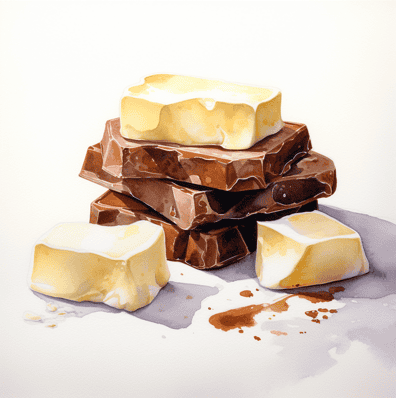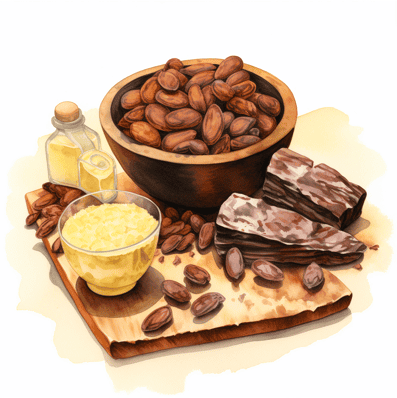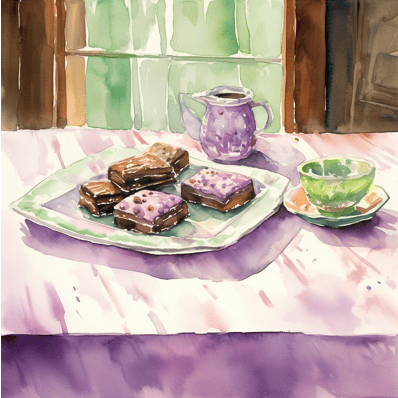
If you’re struggling to choose between cocoa butter vs cacao butter for your skin and culinary adventures, don’t worry—we’ll explore their unique benefits and differences to make your decision easier.
Hi, I’m Hazel
I gave up on skincare after years of issues with acne and sensitive skin.
But after going plant-based, my skin cleared up and even started to glow. Now I help women reveal their natural beauty with simple, delicious plant-based food.
I also used to be a nurse, and love nerding out on nutritional science (high-quality science, that is).

As usual, this post is based on the strongest nutritional evidence I could find with a focus on the simplest, most delicious foods
…because who has time to waste on actions that don’t work?
The quick version:
Cocoa butter and cacao butter both originate from cocoa beans but differ in processing and properties. Cocoa butter is favored for its high smoke point and creamy texture in cooking, while cacao butter is prized in raw chocolate products for its strong flavor. Both offer significant health and beauty benefits, including heart health and skin hydration, and are key ingredients in various beauty products.
The Basics
Both originate from the magical cocoa beans, but their journey from bean to butter is where things differ.
Cocoa Butter: The Creamy Conductor

Cocoa Butter is derived from the cocoa liquor that’s pressed under high pressure to release its fat—known as the butter.
Pure cocoa butter is known for its stable, creamy texture and is a star in chocolate bars and beauty products.
Cacao Butter: The Raw Purist

On the other side, cacao butter comes directly from cacao beans that are cold-pressed, preserving more of their natural compounds.
It’s the go-to for those looking for a strong cacao flavour in raw chocolate products and health-centric recipes.
Health Benefits
Exploring the nutritional landscape of these butters reveals why they’re more than just a treat.
Fat Composition
Both cocoa butter and cacao butter are rich in plant-based fats, but their fat profiles differ slightly.
Cocoa Butter is praised for its balance of unsaturated fatty acids and stearic acid, which is thought to have a neutral effect on cholesterol (1).
Cacao Butter shares a similar fat composition but stands out with its higher levels of certain phytonutrients (remember how it is cold pressed?).
Vitamin Power: E for Excellent
When it comes to vitamins, both butters contain vitamin E, an antioxidant that plays a crucial role in protecting skin from oxidative stress and maintaining heart health (2).
This makes them a great edible fat choice for those looking to enhance their diet with health effects that matter.
Beauty Benefits for Skin and Hair
Both butters are not just good for the inside; they do wonders on the outside too.

Smooth Operators: Skin’s Best Friends
Cocoa butter is a beloved ingredient in skin creams, lip balms and body butter, used extensively for its hydrating properties and ability to reduce the appearance of stretch marks.
Cacao butter offers a similar benefit, with its pure, unrefined form being more likely effective in maintaining skin moisture and elasticity.
Hair Health: Gloss and Growth
Not just skin deep, these butters also contribute to hair health.
The oleic acid in cacao butter makes it a superb conditioner that adds shine and strength to your hair.
Meanwhile, cocoa butter can be applied to the scalp to nourish and reduce dandruff, making it a versatile beauty product.
Culinary Uses
Discover how each butter adds its unique flair to dishes and delights.

Cocoa Butter
Cocoa Butter is a staple in chocolate making, where its creamy texture, high smoke point, and stability at high temperatures make it ideal for creating smooth, luxurious chocolate bars and white chocolate.
It’s also utilised in chocolate products for its ability to enrich and stabilise, ensuring high-quality outcomes.
The high smoke point means it can be used in cooking without degrading, making it a versatile fat source.
Cacao Butter: The Raw Advantage
Cacao Butter shines in recipes that require a potent flavour without heating.
It’s essential in raw chocolate product creation, lending a strong cacao flavour that raw food enthusiasts adore.
Its low melting point is particularly advantageous at low temperatures, preserving the nutritional quality and enhancing dishes with minimal heat.
Comparison in Cooking
Cocoa Butter is highly valued for its high smoke point, making it suitable for cooking at high temperatures where other fats might degrade.
Its ability to remain stable at room temperature also makes it a versatile fat source in a variety of culinary applications, from baking to frying.
In contrast, Cacao Butter is ideal for use at low temperatures due to its low melting point.
This characteristic enhances dishes that require gentle, minimal heat, making it perfect for raw desserts and other health-focused culinary creations where maintaining the integrity of ingredients is key.
Cost and Availability
Making informed choices involves understanding what you’re investing in.
Both butters can be found in health food stores, but cocoa butter might be more prevalent in conventional grocery stores due to its widespread use in chocolate products.
Cacao butter often tags along with a higher price point, reflecting its organic cacao butter labels and appeal in the health food sector.
Consider the long shelf life and most stable fats they offer, which can justify the initial cost, particularly if you value purity and ethical sourcing.
Environmental and Ethical Considerations
Choosing between cocoa and cacao butter also involves a look at their impact on the planet and society.
Sourcing and Sustainability: Beyond the Butter
The production of cocoa butter and cacao butter has significant environmental footprints, especially in South America where cocoa trees flourish.
Fair Trade and Ethical Choices: Making a Difference
Choosing cocoa products and cacao products that support fair-trade practices ensures that the farmers and communities involved receive fair compensation. This helps to improve the lives of those in the supply chains and supports sustainable development in producing regions.
Consumers are increasingly opting for cocoa butter vegan options and cocoa butter substitutes like shea butter or coconut butter that offer alternative benefits.
Cocoa Butter vs Cacao Butter
Both cocoa butter vs cacao butter provide unique advantages for culinary, health, and beauty applications. Whether you value Cocoa Butter for its versatile use in cooking and mainstream beauty products or prefer Cacao Butter for its potent flavour and raw purity in health-centric recipes, your choice can align with your culinary preferences, health goals, and ethical values.
References
Most references below will link to the original peer-reviewed study itself. However, sometimes I will link to a video over at NutritionFacts.org instead, which is by far the single best resource of brutally transparent nutritional evidence you will ever see. Dr Greger tells a great story about the realities of the science and if I think you will benefit more from one of his videos, the link will take you there instead.
Happy nerding!
- Ding EL, Hutfless SM, Ding X, Girotra S. Chocolate and prevention of cardiovascular disease: a systematic review. Nutr Metab (Lond). 2006;3:2. Published 2006 Jan 3. doi:10.1186/1743-7075-3-2
- Roda A, Lambri M. Changes in Antioxidants and Sensory Properties of Italian Chocolates and Related Ingredients Under Controlled Conditions During an Eighteen-Month Storage Period. Nutrients. 2019;11(11):2719. Published 2019 Nov 9. doi:10.3390/nu11112719